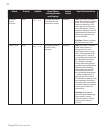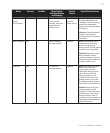
Trilogy200 clinical manual
114
Alarm Priority Audible Visual (Alarm
Indicator Button
and Display)
Device
Action
User/Clinician Action
Low Battery Escalates
from
Medium to
High
• • •
(Medium -
when approx.
20 minutes
remains)
• • • • •
(High - when
approx. 10
minutes
remains)
Medium Priority-
Yellow ashing
button. “Low
Detachable Battery,“
“Low External Battery,”
or “Low Internal
Battery” message
appears in yellow,
On Status Panel, box
around battery is
yellow
High Priority-Red
ashing button. “Low
Detachable Battery”,
“Low External Battery,”
or “Low Internal
Battery” message
appears in red. On
Status panel, box
around battery is red
Operates User: Press Alarm Indicator/
Audio Pause button to silence
alarm. Or, press Left button
(Reset) to reset alarm. Switch
to an alternate battery. Or,
switch to AC power source
and recharge low battery.
Clinician: Switch to alternate
battery or AC power while
you recharge low battery.
If low battery is recharged
and alarm continues, replace
battery.
High
Temperature
Escalates
from
Medium to
High
• • • for
Medium
• • • • •
for High
Yellow ashing
button and yellow
“High Temperature”
message appears. If
condition worsens,
button ashes
red and red “High
Temperature”
message appears.
Operates User: Press Alarm Indicator/
Audio Pause button to
silence alarm. Or, press Left
(Reset) button to reset alarm.
Make sure device is not
close to a heat source. Make
sure tubing is not under any
bedding. Check inlet lter
and clean or replace it if
needed. Make sure cooling
vents are not blocked. If the
ventilator is running o of
the internal or detachable
battery, move to a cooler
location and/or power the
device with AC power or a
lead-acid battery.
If alarm continues, place
patient on alternate source of
ventilation and contact your
health care professional.
Clinician: If alarm continues
after the measures above
have been taken, have device
serviced.


















